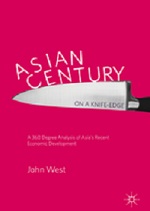Asian Century faces many challenges

John West believes that Asia’s rise is precarious and that China’s dominance on the world stage is not as inevitable as we might think. He argues these points in compelling fashion in his latest book Asian Century… on a Knife-edge, drawing on insights gained in his long career as educator, journalist, researcher and policy maker. West is also a most engaging speaker and his address to AIIA Queensland on May 7 was well received with members taking part in a lengthy discussion in the issues raised.
West’s work has continued to evolve since the book’s release in January 2018, not only regarding the Asian Century implications for Australia but also the maturation of the Trump presidency and growing strategic competition in US-Sino relations. Enduring, however, is the relevance of his motivation for the book, which he cites as three concerning trends: Asian century hype, China obsession, and China threat syndrome. These are characterised by an excessively rosy view of Asian prospects, including a growing fondness for authoritarianism which compounds with the tendency to regard China as the sole significant actor in Asian affairs. The latter, China threat syndrome, convincingly frames the trend of the West to view China and its actions as a threat rather than as an opportunity to collaborate.
In a stocktaking of Asia’s social and economic development, he credits Asia as making miraculous progress over the last 70 years. However, its past successes do not guarantee its ability to address his seven key challenges, which range from the relatively small percentage of Asian value added in global value chains to illicit financial flows and geopolitical struggles. In failing to tackle these issues, likely due to apprehension towards reform, Asia may still become the biggest economy, but it would be “backwards’’ in terms of GDP per capita and innovation. Seemingly, having played catch-up for decades, Asia is unlikely to fully catch up to the West but instead see a continued rivalry and possibly a balance of power. With mounting debt, an aging population, and a non-cohesive region, it may be an Asian century but “it would be a weak Asian century’’.
Australia’s way forward in Asia should note the diminishing US appetite for international affairs and the fragility of China as a prospective superpower, given its authoritarianism and looming demographic and financial problems. According to West, this drives a pressing need to diversify Australian economic and political partnerships, despite the problematic nature of trade relationship with India, for example. The urgency of this need is framed by the prospects of population spill-over induced by climate change, Asia’s vulnerability to terrorist attacks, and the potential flashpoint of Taiwan. Diverse engagement in Asia with a firm basis in co-operation will ultimately ensure that the Asian Century is one with Australia’s interests at heart.
The AIIA Queensland audience welcomed John West’s refreshing perspective on the region. More on this timely appraisal of the challenges of Asia can be found on the AIIA podcast. Asian Century… on a Knife-edge is freely available online and the work of the Asian Century Institute, of which John West is the Executive Director, can be found here.